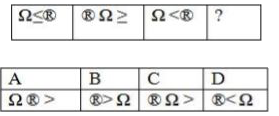What will come in place of question mark (?) in the following series questions?
1,5,?,30,55,91
A)13
B)10
C)9
D)14
The correct Answer is:D
To solve the series: 1, 5, ?, 30, 55, 91, we need to identify the pattern in the differences between the terms.
Step 1: Identify the given terms in the series.
The series is: 1, 5, ?, 30, 55, 91.
Step 2: Calculate the differences between consecutive terms.
- From 1 to 5: 5−1=4
- From 5 to ?: Let’s denote this unknown term as K.
- From K to 30: 30−K
- From 30 to 55: 55−30=25
- From 55 to 91: 91−55=36
So, we have the differences:
- First difference: 4
- Second difference: K−5
- Third difference: 30−K
- Fourth difference: 25
- Fifth difference: 36
Step 3: Analyze the differences.
The differences we have are: 4, K−5, 30−K, 25, 36.
Step 4: Look for a pattern in the differences.
Notice that:
- 4 is 22
- 25 is 52
- 36 is 62
This suggests that the differences might be perfect squares. If we assume that the difference between 5 and K is 32 (which is 9), we can set up the equation:
K−5=9
Thus,
K=5+9=14
Step 5: Verify the next difference.
Now, we need to check if the difference from K (which we found to be 14) to 30 is 42 (which is 16):
30−K=30−14=16
This is correct.
Step 6: Confirm the differences.
Now we have:
- From 1 to 5: 4 (which is 22)
- From 5 to 14: 9 (which is 32)
- From 14 to 30: 16 (which is 42)
- From 30 to 55: 25 (which is 52)
- From 55 to 91: 36 (which is 62)
The differences are indeed perfect squares, confirming our assumption.
Final Answer:
The value that comes in place of the question mark (?) is 14.
---
The series is: 1, 5, ?, 30, 55, 91.
- From 1 to 5: 5−1=4
- From 5 to ?: Let’s denote this unknown term as K.
- From K to 30: 30−K
- From 30 to 55: 55−30=25
- From 55 to 91: 91−55=36
- First difference: 4
- Second difference: K−5
- Third difference: 30−K
- Fourth difference: 25
- Fifth difference: 36
The differences we have are: 4, K−5, 30−K, 25, 36.
Notice that:
- 4 is 22
- 25 is 52
- 36 is 62
K−5=9
Thus,
K=5+9=14
Now, we need to check if the difference from K (which we found to be 14) to 30 is 42 (which is 16):
30−K=30−14=16
This is correct.
Now we have:
- From 1 to 5: 4 (which is 22)
- From 5 to 14: 9 (which is 32)
- From 14 to 30: 16 (which is 42)
- From 30 to 55: 25 (which is 52)
- From 55 to 91: 36 (which is 62)
The value that comes in place of the question mark (?) is 14.
Topper's Solved these Questions
- NUMBER SERIESBOOK - ADDA247CHAPTER - NUMBER SERIESEXERCISE - PRELIMS QUESTIONS (LEVEL - 2)
50 Videos
- NUMBER SERIESBOOK - ADDA247CHAPTER - NUMBER SERIESEXERCISE - MAINS QUESTIONS
30 Videos
- NUMBER SERIESBOOK - ADDA247CHAPTER - NUMBER SERIESEXERCISE - PREVIOUS YEAR QUESTIONS
63 Videos
- MIXTURE & ALLIGATIONBOOK - ADDA247CHAPTER - MIXTURE & ALLIGATIONEXERCISE - PREVIOUS YEAR QUESTIONS
21 Videos
- NUMBER SYSTEM, SIMPLIFICATION AND APPROXIMATION BOOK - ADDA247CHAPTER - NUMBER SYSTEM, SIMPLIFICATION AND APPROXIMATION EXERCISE - PREVIOUS YEAR QUESTION
60 Videos
Similar Questions
Knowledge Check
What will come in the place of question mark (?) in the below series?
 A1.AB2.DC3.BD4.C
A1.AB2.DC3.BD4.CWhat will come in place of the question mark (?) in the following questions?
3×?+30=0A-15B15C10DNone of theseWhat will come in place of the question mark (?) in the following questions ?
40%of ?=240A60B6000C960D600
What will come in the place of question mark(?) in each of the following question ?

View SolutionWhat will come in place of the question mark (?) in the following questions ?
1400×?=1050
View SolutionWhat will come in place of the question mark (?) in the following questions ?
60=?% of 400
View SolutionWhat will come in place of the question mark (?) in the following questions ?
35+15×1⋅5=?
View SolutionWhat will come in place of question mark (?) in the following questions ?
(20% of 1450) - (30% of 890) = ?
View Solution

